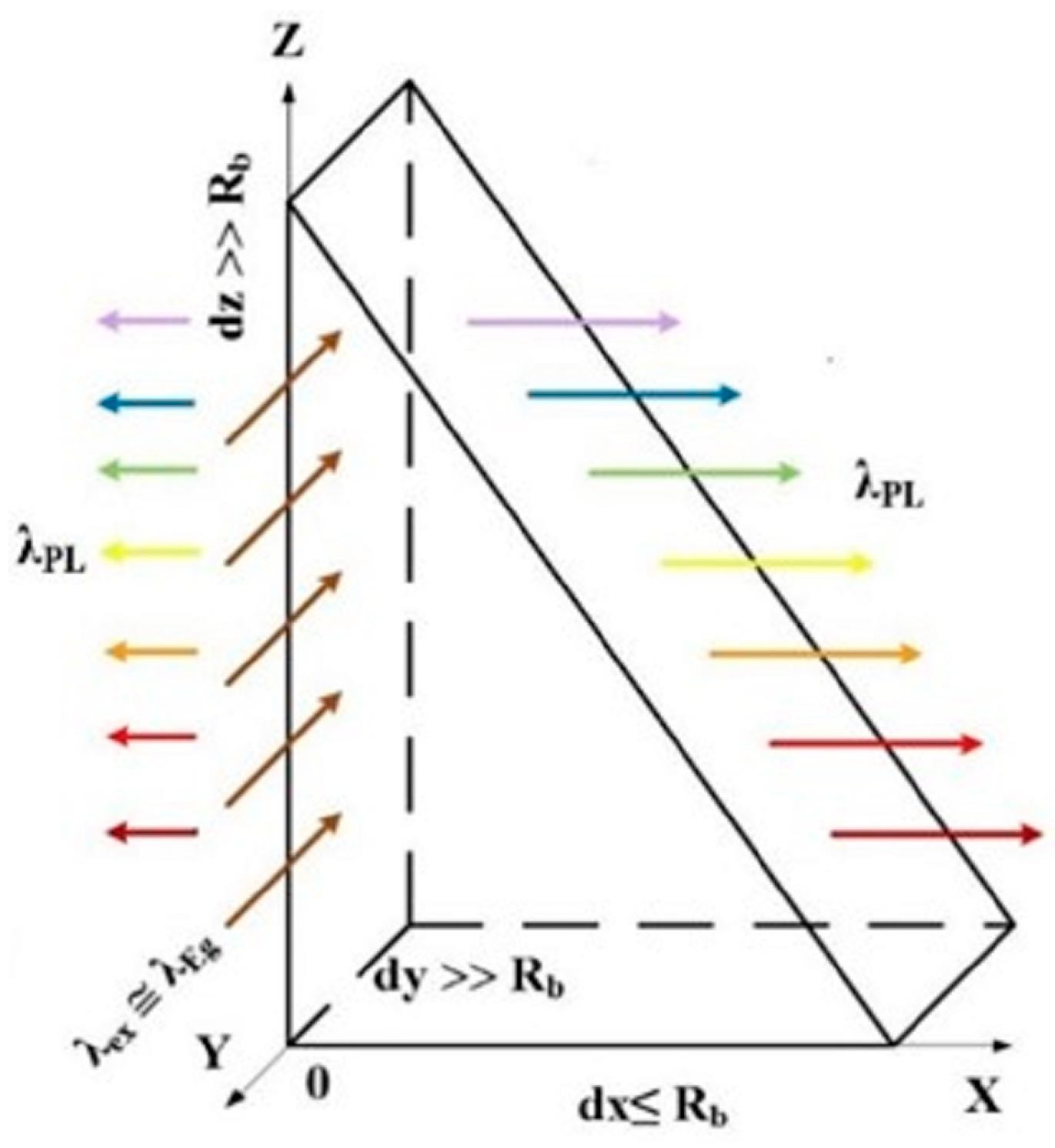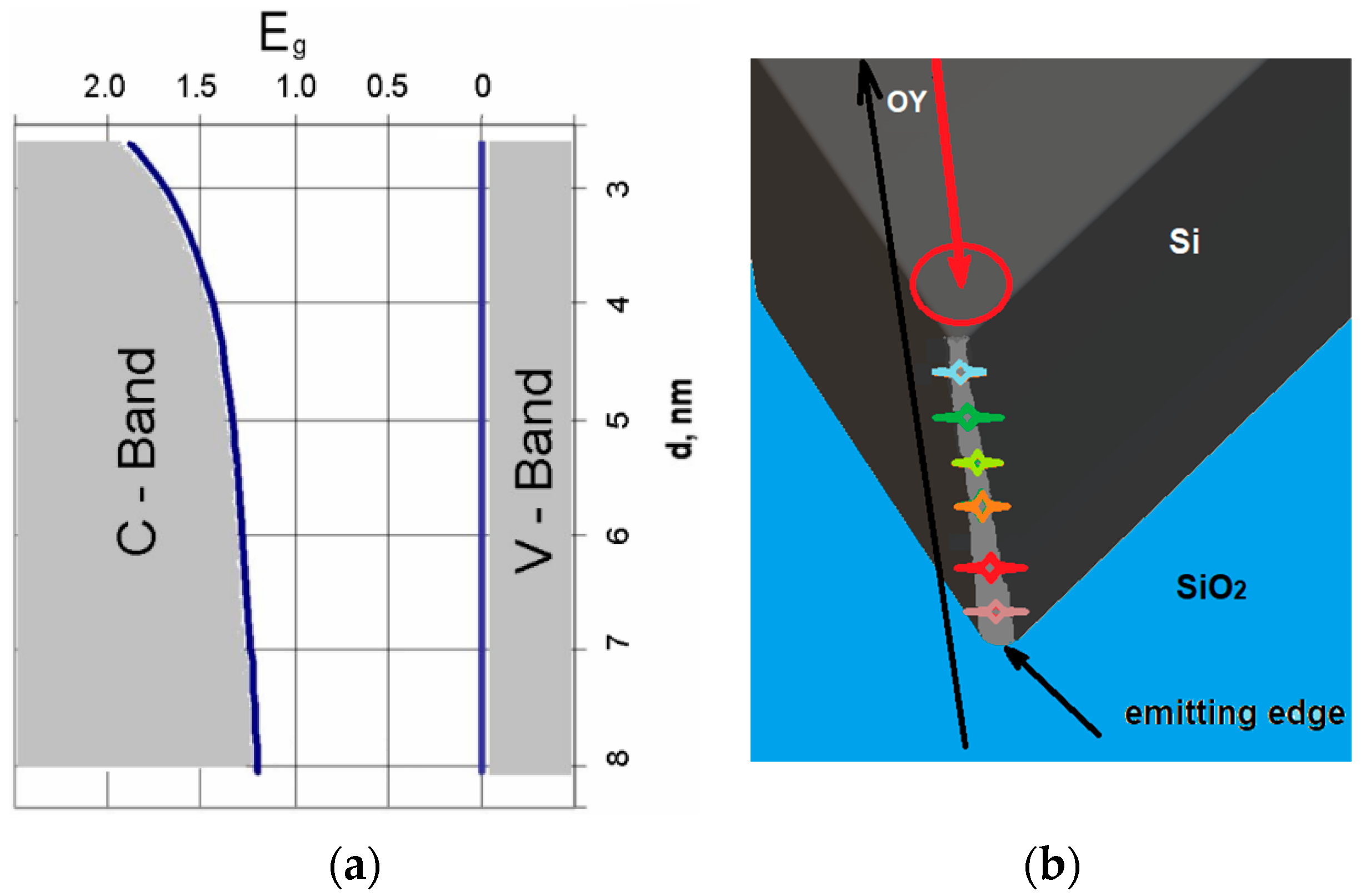Quantum Prism—Nano Source of Light with Dispersive Spectrum and Optical Upconversion
Abstract
:1. Introduction
2. Theory and Materials
3. Results and Discussion
4. Conclusions
Author Contributions
Funding
Data Availability Statement
Conflicts of Interest
References
- Motz, J.T.; Hunter, M.; Galindo, L.H.; Gardecki, J.A.; Kramer, J.R.; Dasari, R.R.; Feld, M.S. Optical fiber probe for biomedical Raman spectroscopy. Appl. Opt. 2004, 43, 542–554. [Google Scholar] [CrossRef] [PubMed]
- Brus, L.E. Electron–electron and electron-hole interactions in small semiconductor crystallites: The size dependence of the lowest excited electronic state. J. Chem. Phys. 1984, 80, 4403–4444. [Google Scholar] [CrossRef]
- Medvid’, A.; Fukuda, Y.; Michko, A.; Onufrievs, P.; Anma, Y. 2D lattice formation by YAG:Nd laser on the surface of Ge single crystal. Appl. Surf. Sci. 2005, 244, 120–123. [Google Scholar] [CrossRef]
- Medvid’, A.; Mychko, A.; Gnatyuk, V.; Levytskyi, S.; Naseka, Y. Mechanism of nano-cone formation on Cd0.9Zn0.1Te crystal by laser radiation. Opt. Mater. 2010, 32, 836–839. [Google Scholar] [CrossRef]
- Medvid’, A.; Dmytruk, I.; Onufrijevs, P.; Pundyk, I. Quantum confinement effect in nanohills formed on a surface of Ge by laser radiation. Phys. Status Solidi C 2007, 4, 3066–3069. [Google Scholar] [CrossRef]
- Medvid’, A.; Dmitruk, I.; Onufrijevs, P.; Pundyk, I. Properties of nanostructure formed on SiO2/Si interface by laser radiation. Solid State Phenom. 2008, 131–133, 559–562. [Google Scholar]
- Medvid’, A.; Onufrijevs, P. Properties of nanocones formed on a surface of semiconductors by laser radiation: QC effect of electrons, phonons, and excitons. Nanoscale Res. Lett. 2011, 6, 582. [Google Scholar] [CrossRef] [PubMed]
- Takahahara, T.; Takeda, K. Theory of the quantum confinement effect on excitons in quantum dots of indirect-gap materials. Phys. Rev. B 1992, 46, 15578–15581. [Google Scholar] [CrossRef]
- Li, J.; Wang, L. Comparison between Quantum Confinement Effect of Quantum Wires and Dots. Chem. Mater. 2004, 16, 4012–4015. [Google Scholar] [CrossRef]
- Morozov, Y.V.; Draguta, S. Defect-Mediated CdS Nanobelt Photoluminescence Up-Conversion. J. Phys. Chem. C 2017, 121, 16607–16616. [Google Scholar] [CrossRef]
- Sellers, D.G.; Doty, M.F. Design, synthesis and photophysical properties of InP/CdS/CdSe and CdTe/CdS/CdSe (core/shelVshell) quantum dots for photon upconversion. In Proceedings of the 2015 IEEE 42nd Photovoltaic Specialist Conference (PVSC), New Orleans, LA, USA, 14–19 June 2015. [Google Scholar] [CrossRef]
- Goldschmidt, J.C.; Fischer, S. Upconversion for Photovoltaics—A Review of Materials, Devices and Concepts for Performance Enhancement. Adv. Opt. Mater. 2015, 3, 510–535. [Google Scholar] [CrossRef]
- Sheik-Bahae, M.; Epstein, R.I. Optical Refrigeration. Nat. Photonics 2007, 1, 693–699. [Google Scholar] [CrossRef]
- Kang, H. Crystalline Silicon vs. Amorphous Silicon: The Significance of Structural Differences in Photovoltaic Applications. IOP Conf. Ser. Earth Environ. Sci. 2021, 726, 012001. [Google Scholar] [CrossRef]
- Farr, E.P.; Quintana, J.C.; Reynoso, V.; Ruberry, J.D.; Shin, W.R.; Swartz, K.R. Introduction to Time-Resolved Spectroscopy: Nanosecond Transient Absorption and Time-Resolved Fluorescence of Eosin B. J. Chem. Educ. 2018, 95, 864–871. [Google Scholar] [CrossRef]
- Chen, E.Y.; Li, Z.; Milleville, C.C.; Lennon, K.R.; Zide, J.M.O.; Doty, M.F. CdSe(Te)/CdS/CdSe Rods Versus CdTe/CdS/CdSe Spheres: Morphology-Dependent Carrier Dynamics for Photon Upconversion. IEEE J. Photovolt. 2018, 8, 746–751. [Google Scholar] [CrossRef]
- Skuja, L.; Ollier, N.; Kajihara, K.; Smits, K. Creation of glass-characteristic point defects in crystalline SiO2 by 2.5 MeV electrons and by fast neutrons. J. Non-Cryst. Solids 2019, 505, 252–259. [Google Scholar] [CrossRef]
- Skuja, L.; Ollier, N.; Kajihara, K. Luminescence of non-bridging oxygen hole centers as a marker of particle irradiation of α-quartz. Radiat. Meas. 2020, 135, 106373–106377. [Google Scholar] [CrossRef]
- Zwei, P.P. Bemerkungen uber Denunterschied von Lumineszenz- Und Temperaturatutstrahlung. Z. Fur Phys. 1929, 57, 739–746. [Google Scholar]




Disclaimer/Publisher’s Note: The statements, opinions and data contained in all publications are solely those of the individual author(s) and contributor(s) and not of MDPI and/or the editor(s). MDPI and/or the editor(s) disclaim responsibility for any injury to people or property resulting from any ideas, methods, instructions or products referred to in the content. |
© 2024 by the authors. Licensee MDPI, Basel, Switzerland. This article is an open access article distributed under the terms and conditions of the Creative Commons Attribution (CC BY) license (https://creativecommons.org/licenses/by/4.0/).
Share and Cite
Medvids, A.; Ščajev, P.; Miasojedovas, S.; Hara, K. Quantum Prism—Nano Source of Light with Dispersive Spectrum and Optical Upconversion. Nanomaterials 2024, 14, 1277. https://doi.org/10.3390/nano14151277
Medvids A, Ščajev P, Miasojedovas S, Hara K. Quantum Prism—Nano Source of Light with Dispersive Spectrum and Optical Upconversion. Nanomaterials. 2024; 14(15):1277. https://doi.org/10.3390/nano14151277
Chicago/Turabian StyleMedvids, Arturs, Patrik Ščajev, Saulius Miasojedovas, and Kazuhiko Hara. 2024. "Quantum Prism—Nano Source of Light with Dispersive Spectrum and Optical Upconversion" Nanomaterials 14, no. 15: 1277. https://doi.org/10.3390/nano14151277




